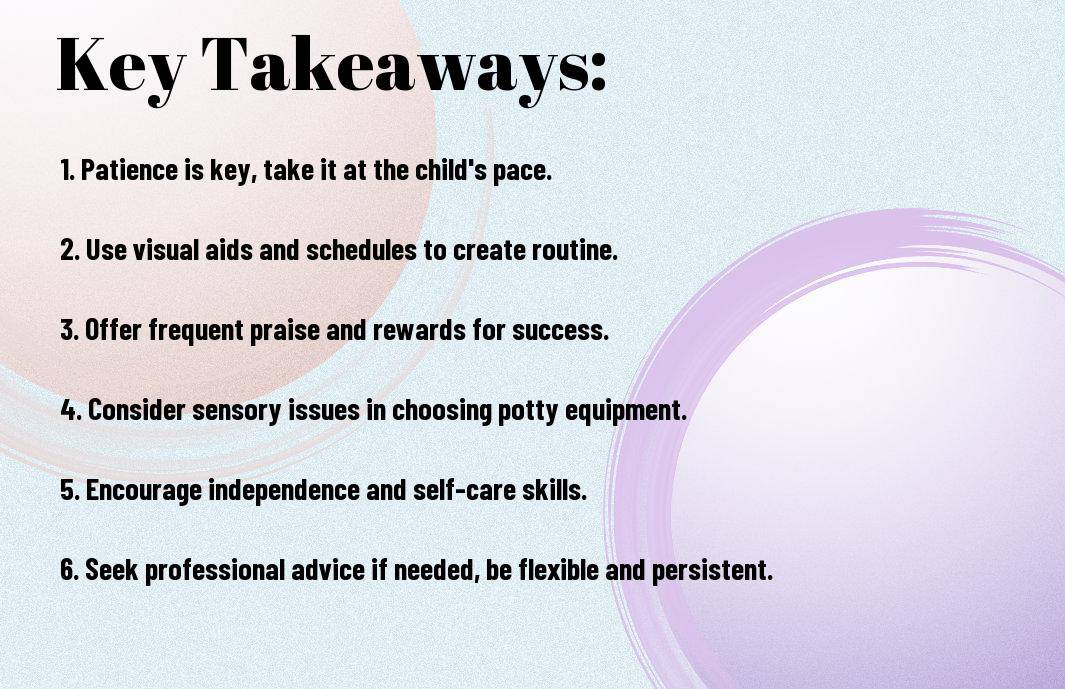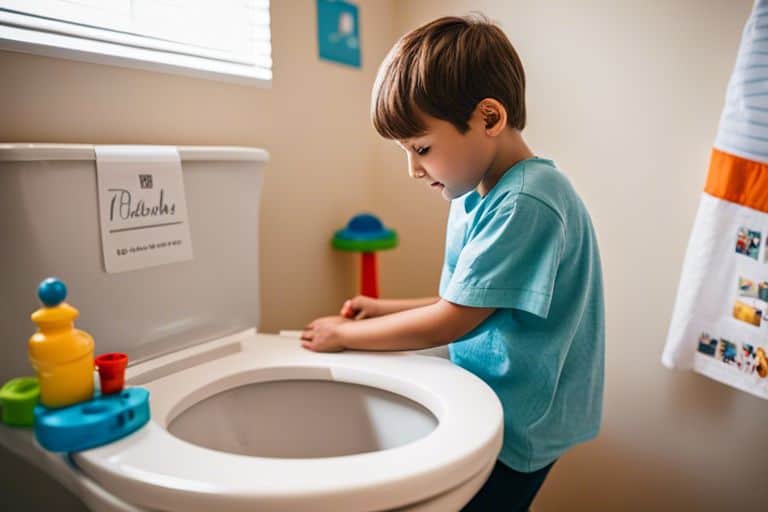Adapting to potty training for children with autism can be a challenging journey for parents. It requires patience, understanding, and a tailored approach to meet the specific needs of each child. With the right guidance, successful potty training is achievable for children on the autism spectrum. In this blog post, we will provide autism potty training: Tips and tricks for parents designed to help families navigate this important milestone. We will cover important strategies, potential obstacles, and offer practical advice to support parents in this unique challenge. Our aim is to empower parents with the knowledge and tools they need to make potty training a positive experience for their children with autism.
Key Takeaways:
- Consistency: Consistency is key when potty training children with Autism. Stick to a routine and use the same approach each time to help them feel more comfortable and confident.
- Visual aids: Visual aids can be incredibly helpful for children with Autism. Use visual schedules, social stories, and picture prompts to explain the process of potty training and make it easier for them to understand.
- Patience and praise: Potty training may take longer for children with Autism, so be patient and offer plenty of praise and positive reinforcement for their efforts, no matter how small. Celebrate each success to build their confidence and motivation.

Preparing for Potty Training
Before starting the potty training process with a child with autism, it’s important to take some time to prepare. Patience, consistency and understanding are key when embarking on this journey. It’s helpful to begin by recognising signs of readiness, setting the stage for success and selecting appropriate potty training equipment.
Recognizing Signs of Readiness
Recognising signs of readiness is crucial before beginning the potty training process. Some signs to look out for include showing discomfort in dirty diapers, having regular bowel movements, and starting to express awareness of the sensation of needing to use the toilet. It’s important to be observant and patient, as every child is different and may show these signs in their own time. Once these signs are present, it may be a good indication that your child is ready to start the potty training process.
Setting the Stage for Success
Setting the stage for success involves creating a supportive and comfortable environment for potty training. Establishing a routine and staying consistent can help in creating a sense of predictability for the child. It’s important to introduce the concept of using the potty in a positive and encouraging manner, whilst also being understanding of any fears or anxieties the child may have. Providing visual supports, such as picture schedules or social stories, can also be beneficial in helping the child understand the potty training process.
It’s crucial to be patient and persistent during this stage, as it may take time for the child to become fully comfortable with the idea of using the potty. Offering plenty of praise and reinforcement for any attempts or successes can also help to motivate the child and reinforce positive behaviour.
When preparing for potty training, it’s essential to consider the selection of appropriate potty training equipment. Factors to take into account can include the child’s size, comfort, and sensory preferences. Choosing the right equipment can have a significant impact on the child’s comfort and confidence during the potty training process, so it’s important to explore different options and find the most suitable fit for your child’s unique needs.
Selection of Appropriate Potty Training Equipment
When selecting potty training equipment for a child with autism, it’s important to consider factors such as comfort, stability, and sensory sensitivities. Some children may have a preference for specific materials, colours, or designs, so it’s beneficial to involve the child in the selection process if possible. Additionally, choosing equipment that is easy to clean and maintain can make the potty training experience more manageable for both the child and the caregiver.

Strategies for Successful Potty Training
When it comes to potty training children with autism, establishing consistent routines is essential. This provides the predictability and structure that children with autism thrive on. For guidance on how to create consistent routines, parents and carers can refer to the Toileting – a guide for parents and carers provided by the National Autistic Society.
Establishing Consistent Routines
Creating a consistent schedule for bathroom breaks, mealtimes, and bedtime can help children with autism understand when it’s time to use the potty. Using visual schedules and timers can also reinforce the routine, providing clear cues for when it’s time to try using the toilet.
Maintaining consistency across different environments, such as home, school, and other familiar places, is also crucial. This helps to reinforce the routine and allows the child to feel comfortable and confident in using the potty wherever they are.
Using Visual Supports and Social Stories
Visual supports and social stories can be valuable tools for potty training children with autism. These resources can help children visualise the process of using the toilet and understand the expected behaviours associated with it. By creating personalised social stories and visual schedules, parents and carers can provide clear, step-by-step guidance for the child.
Visual supports and social stories can also help children with autism prepare for any changes to their routine, reducing anxiety and increasing their sense of control over the potty training process.
Furthermore, consulting with professionals specialising in autism and potty training can offer tailored advice and recommendations, taking into account the specific needs and sensitivities of the child.
Positive Reinforcement Techniques
Positive reinforcement techniques such as praise, rewards, and preferred activities can motivate and encourage children with autism during the potty training process. It’s important to identify the specific rewards or incentives that are highly motivating for the child, ensuring that they are positively reinforcing their progress.
Consistency in using positive reinforcement across different environments and situations is crucial for maximising its effectiveness. Parents and carers should also be prepared to adapt the rewards and incentives based on the child’s preferences and needs.
Communication and Prompting Strategies
Communication and prompting strategies play a significant role in supporting children with autism during potty training. Using clear, simple language and visual prompts can help the child understand the expectations and steps of using the toilet. Consistent and gentle prompting can guide the child through the process and provide reassurance.
It’s essential to consider the individual communication and sensory needs of the child, ensuring that the chosen strategies are appropriate and effective for them.
Addressing Sensory Sensitivities
Children with autism may have sensory sensitivities that impact their experience of using the toilet. Understanding and addressing these sensitivities is crucial for creating a comfortable and supportive environment for potty training. For example, using soft toilet paper, providing privacy during the process, and considering sensory-friendly toileting equipment can make a significant difference.
Parents and carers should observe the child’s responses and preferences, adjusting the environment and approach as needed to accommodate their sensory sensitivities.

Overcoming Common Challenges
Handling Resistance and Setbacks
It is common for children with autism to experience resistance and setbacks during the potty training process. It is important to approach these challenges with patience and understanding. If your child is resistant to using the potty or experiences setbacks, consider taking a break and then reintroducing the process in a calm and supportive manner. Consistency and positive reinforcement are key to managing resistance and setbacks.
Dealing with Accidents
Accidents are a normal part of the potty training process, especially for children with autism. It is crucial to remain calm and avoid showing frustration when accidents occur. Using visual aids and social stories can help your child understand the importance of using the potty and can reduce the likelihood of accidents. Be prepared for accidents and have a plan in place for how to handle them in a supportive way.
Children with autism may have difficulty recognising the physical cues that indicate they need to use the potty, so it is important to be patient and understanding when accidents happen.
Transitioning to Public Restrooms
Transitioning from using the potty at home to using public restrooms can be challenging for children with autism. It is important to prepare them for this transition by familiarising them with public restroom environments and routines. Consider using social stories or visual schedules to help your child understand what to expect when using public restrooms. It is also helpful to identify family-friendly and accessible facilities in advance to make the transition smoother and less stressful.
Keep in mind that transitioning to public restrooms may take time and patience, so be prepared to support your child through this process.
The Role of Professionals and Support Networks
When it comes to potty training children with autism, the role of professionals and support networks cannot be overstated. Occupational therapists play a crucial role in helping children with autism develop the necessary skills for potty training. They can provide individualized strategies and support to address sensory issues, fine motor skills, and other challenges that may affect potty training. In addition to occupational therapists, other professionals such as speech therapists, behaviour analysts, and special education teachers can also provide valuable input and support.
Working with Occupational Therapists
Occupational therapists can help identify any sensory processing challenges that may be hindering potty training progress. They can provide sensory-friendly strategies and interventions to address these challenges, making the potty training process more comfortable for the child. They can also offer guidance on developing fine motor skills, such as the dexterity needed for undressing and using the toilet independently.
Seeking Support from Autism Communities
Connecting with autism communities can provide parents with valuable support, guidance, and understanding from others who have experienced similar challenges. Online forums, local support groups, and autism advocacy organisations can offer a wealth of resources and advice for parents navigating the potty training journey with a child on the autism spectrum.
Seeking support from autism communities can also help parents feel less isolated and more empowered as they connect with others who can relate to their experiences and offer practical tips and emotional support.
Utilizing Educational Resources
There are a variety of educational resources available to help parents and caregivers support potty training for children with autism. These resources may include visual schedules, social stories, and educational videos specifically designed to teach and reinforce potty training concepts in a way that is accessible and meaningful for children with autism.
Utilising educational resources tailored to the unique learning styles and needs of children with autism can positively impact their potty training journey by providing clear and consistent guidance in a format that resonates with them.
Conclusion
In conclusion, potty training children with autism requires patience, consistency, and understanding. By following the tips provided in this guide, such as creating a visual schedule, using positive reinforcement, and maintaining a calm environment, parents and caregivers can help their child with autism successfully transition to using the toilet. It is important to remember that every child is unique, and what works for one child may not work for another. It may take time and effort, but with the right approach and support, potty training can be achieved. Always seek advice from professionals in the field of autism if you have any concerns or need further assistance. Remember, the key is to remain patient and supportive throughout the process. With dedication and understanding, potty training can be a successful milestone for children with autism.
Potty Training Tips for Children with Autism
Q: What are some tips for potty training a child with autism?
A: Potty training a child with autism requires patience and understanding. It is important to create a consistent routine, use visual aids, and provide positive reinforcement for any progress.
Q: How do I know if my child with autism is ready for potty training?
A: Look for signs of readiness such as showing interest in the bathroom, being able to follow simple instructions, and having dry periods of at least two hours during the day.
Q: What are some strategies for making the potty training process easier for a child with autism?
A: Using social stories, creating a visual schedule, and offering sensory-friendly potty training equipment can help make the process easier for a child with autism.
Q: How can I help my child with autism overcome any fear or anxiety related to potty training?
A: Gradually desensitising your child to the bathroom environment, using social rewards, and teaching relaxation techniques can help alleviate fear or anxiety related to potty training.
Q: What should I do if my child with autism is resistant to potty training?
A: Take a step back and reassess if your child is truly ready for potty training. It may be helpful to consult with a professional or consider alternative approaches if your child is resistant to potty training.
Q: Are there any resources or support available for parents potty training a child with autism?
A: There are various online resources, support groups, and organisations that provide guidance and support for parents potty training a child with autism.
Q: What are the common mistakes to avoid when potty training a child with autism?
A: Avoiding inconsistency, using harsh discipline, and rushing the process are common mistakes to avoid when potty training a child with autism. It is essential to be patient and understanding throughout the process.






